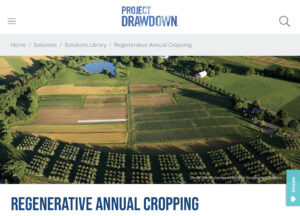
Regenerative Agriculture
Building on conservation agriculture with additional practices, regenerative annual cropping can include compost application, green manure, and organic production. It reduces emissions, increases soil organic matter, and sequesters carbon.
“ We estimate regenerative annual cropping will increase from an estimated 11.84 million hectares today to 219.16–320.45 million hectares by 2050. This rapid adoption is based in part on the historic growth rate of organic agriculture, as well as the projected conversion of conservation agriculture to regenerative annual cropping over time. This increase could result in a total reduction of 15.12–23.21 gigatons of carbon dioxide equivalent from sequestration and reduced emissions. Regenerative annual cropping could provide a US$2.34–3.52 trillion lifetime net operational savings and lifetime net profit of US$134.40–205.35 billion on an investment of US$77.10-115.27 billion.”
https://drawdown.org/solutions/regenerative-annual-cropping?_ga=2.70764373.47264405.1674927844-1799888840.1674927844

